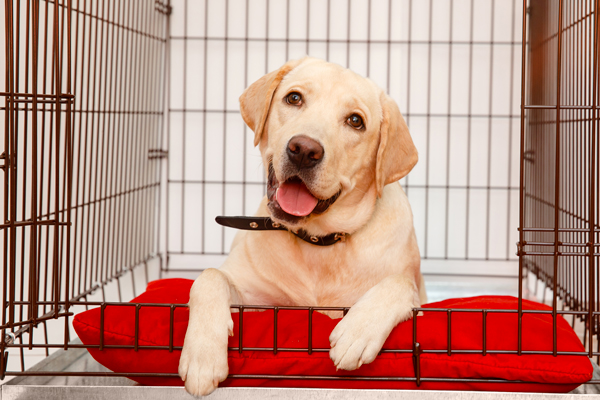 So you have a new puppy in your home. Yay! Chances are, the first thing you want them to learn is where to “go potty.” We’ve put together this resource for those who are looking for the quickest and most effective way to house-train a new puppy. This method is backed by behaviorists and dog lovers alike and will work on a dog no matter what their age.
So you have a new puppy in your home. Yay! Chances are, the first thing you want them to learn is where to “go potty.” We’ve put together this resource for those who are looking for the quickest and most effective way to house-train a new puppy. This method is backed by behaviorists and dog lovers alike and will work on a dog no matter what their age.
When training a new desired behavior with your puppy, remember: repetition is necessary. Your puppy does not instinctively know what is expected of them and must be shown the behavior that is expected, such as the proper place and time to eliminate.

A crate is your potty-training best friend. During times in which you cannot watch your puppy (such as when you are working or busy) it is important to use a crate. Think of it in the same way as a playpen for a child. Even if you are leaving the room for just a short time, a lot of mischief can happen. Would you leave a toddler in the house alone “for just a minute”?
Crate training should always be a positive experience for your puppy.
 Wild dogs utilize a “den” as an integral part of their upbringing and safety zone. The same concept applies to a crate! It is meant to be a safe and comfortable place for your puppy.
Wild dogs utilize a “den” as an integral part of their upbringing and safety zone. The same concept applies to a crate! It is meant to be a safe and comfortable place for your puppy.
Giving your pup a special “crate-only” treat is a great way to introduce them to their crate. The only time the puppy should receive this treat is when they are in their crate so they begin to associate the crate as a place to get cool treats!
Housebreaking Routine
You may have a few accidents on the first couple of tries, but don’t be discouraged! To avoid overnight accidents for the first few weeks, follow this night to morning routine:
- Set your alarm for about three hours after your bed time. When the alarm goes off, go to the crate and carry the puppy outside. Place him on the ground and encourage them to eliminate. Give your puppy lots of praise when they do, and then bring them back to the crate.*
- Set the alarm for another three hours and get back to sleep. When the alarm goes off, repeat the process.
- After about a week of this routine and IF it has been successful (no messes in the crate), then you can set the alarm for longer intervals (about halfway through your sleep routine) only having to get up once in the night. Follow the same process as outlined above.
- In the morning, take your puppy outside before anything else. Feed the puppy and then place them in the crate (you can feed the puppy in the crate to create a positive environment if your puppy is struggling to accept the crate).
- Follow your regular morning routine, and then walk your puppy one more time before leaving the house.

*If the crate is too large, your pet may use this opportunity to soil on one side and sleep in the other. The best way to prevent this is to buy a crate with a divider that will accommodate your pet when they are fully grown. The space should be large enough that there is only room for the puppy to stand up and lay down comfortably.
As the puppy begins to show reliability over a several-week period, provide more room every few days by moving the divider further back. If the puppy messes in their crate, correct the behavior by moving the divider back to the previous size in which the puppy was reliable. Give your pup a little more time to learn and then repeat the spacing process.
Whenever you remove the puppy from the crate or just want the puppy to “go potty” take them to the door that will always be used to “go outside.” Use the same door, same area and same commands throughout the training period. Repetition is key! Using the same phrases helps your puppy begin to understand the command and/or praise.
Tip: Make sure your backyard is dog-friendly!
 Puppy Umbilical Cord Method
Puppy Umbilical Cord Method
If you are struggling with accidents around the house during this process, try the Puppy Umbilical Cord Method. This involves tethering your puppy to leashes around your home when you are unable to give them your full attention. This “Umbilical Cord” tethered near you helps limit their ability to wander off and eliminate somewhere in the house (or get into mischief!) It takes just a couple of seconds for a puppy to have a little accident on your carpet, and it is extremely hard, if not impossible to keep a constant eye on your puppy 100% of the time. With this method, you will be able to prevent these accidents and even catch them in the act.
Ideally, this is done with a lead about six feet long that is either attached to your person or near you. Of course, your puppy will need a harness or collar that fits them nicely as well. In this method, you will bring your puppy all around the house with you. This gives them the opportunity to move around, get used to a leash and allow you to supervise them much more easily.
Important Reminders
- Do not allow the puppy to eliminate alone or while loose in the yard during housebreaking. You always want to have your puppy close, which can be achieved with a leash. Give your puppy plenty of time (10-15 minutes) to eliminate, being careful to not “rush” the process. When the puppy eliminates, praise them with “Good Outside” and give them a treat.
- Correction should only happen when you catch your puppy in the act. Punishing them after the fact is ineffective. Your puppy won’t be able to understand what is “bad” if you are pointing at an old mess in the carpet. Positive reinforcement is most useful in this process.
- It is important to have your puppy on a strict feeding schedule so you know what to expect from their routine.
- If your puppy does not eliminate even after staying outside for 15 minutes, you can place the puppy inside their crate for an additional 15 and start again from the beginning.
Follow these instructions and your puppy will surely pick up on what you’re putting down. The more strict you are with these protocols, the more quickly they will learn their routine – which dogs thrive on! With some patience and persistence, they will be potty-trained in no time! As an added bonus, they will find safety in their “den” and more respect for your as their leader.






